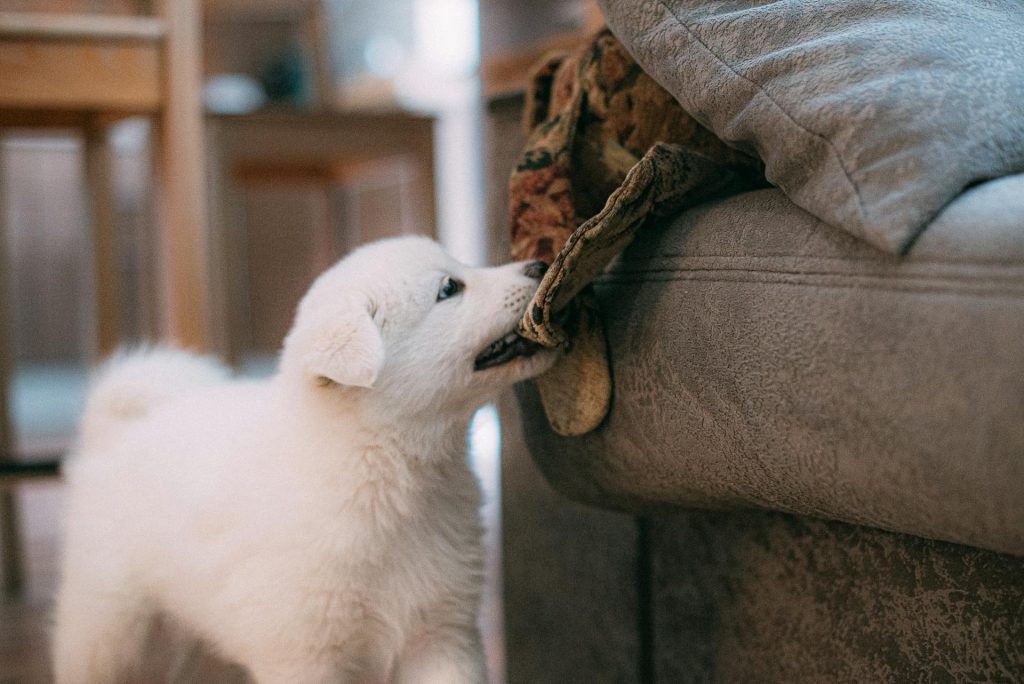
15 Genius Tricks to Stop Pets from Chewing Furniture (For Good)
If your dog is gnawing on the couch or your cat has turned your table legs into a scratching post, you’re not alone. Chewing is one of the most frustrating pet behaviors—especially when it targets furniture you actually like. But before you reach for harsh sprays or scold your furry friend, know this: chewing is natural. It's how puppies and kittens learn, how pets relieve stress, and sometimes how they try to get your attention. These 15 genius tricks will help you stop pets from chewing furniture—without yelling, guilt, or expensive damage. Each tip works for both dogs and cats, and you don’t need fancy gear or obedience school to start.
1. Understand the Root Cause of the Chewing
Before you can stop pets from chewing furniture, you need to figure out why it’s happening. Is your puppy teething? Is your cat bored or stressed? Are they getting enough mental stimulation? Dogs often chew to release energy or soothe anxiety. Cats may chew wooden legs or fabric if they’re under-stimulated or lacking vertical space to climb.
According to Fear Free Pets, recognizing the emotional or developmental triggers behind destructive behavior is key to choosing the right fix. A teething puppy needs chew toys—not punishment. A bored adult dog may need enrichment. Identifying the source is step one.
2. Offer Chew-Friendly Alternatives (And Make Them Irresistible)
Redirecting your pet’s behavior is often more effective than trying to stop it cold. Provide a variety of safe, textured chew options—like rubber bones, plush toys, or crinkly fabric for dogs; or sisal rope, cardboard scratchers, and soft chew mice for cats. Bonus points if the material mimics whatever they’ve been targeting.
Make the new option more appealing: try freezing peanut butter inside a toy, using catnip or silvervine spray, or rotating toys weekly to maintain novelty. If you catch them chewing the right item, reward immediately with praise or a treat. This builds the habit without frustration or confusion.
3. Use a Safe Deterrent Spray (But Only as a Backup)
Deterrent sprays—like bitter apple or citrus—can help protect furniture from determined chewers, but they work best when paired with training and redirection. Never rely on them alone, and always test a small spot to ensure the spray won’t stain or damage the fabric.
If your pet avoids the sprayed area, make sure they have a clear “yes” space: an approved chew toy nearby or a play corner with distractions. And avoid homemade sprays with essential oils unless they’re vet-approved—some ingredients are toxic to cats and dogs.
4. Puppy or Kitten? Respect the Teething Phase
Just like babies, puppies and kittens go through a teething stage. For dogs, this usually happens between 3 to 6 months of age and peaks around 4 months. During this time, chewing helps relieve discomfort and loosen baby teeth. For kittens, chewing may also happen during molar development and as part of exploring textures.
According to VCA Canada, frozen chew toys, wet washcloths, or gentle rubber rings can be soothing for teething puppies. Offer a “cold corner” with safe textures and praise every time your pet chooses it over your chair leg.
5. Prevent Boredom with Enrichment and Exercise
A bored pet is a destructive pet. If your dog hasn’t been walked or your cat hasn’t had a good hunt-and-pounce session lately, your furniture might pay the price. Enrichment is the antidote. This means physical exercise and mental stimulation, especially when you’re not home.
Try puzzle feeders, scent games, or DIY cardboard mazes. Rotate toys weekly. Use suction-cup window toys for cats or hide kibble in towels for dogs. A tired brain is less likely to chew out of frustration. Build enrichment into your daily routine—even five minutes here and there makes a difference.
6. Block Access with Furniture Shields or Covers
Until the chewing phase is under control, protect your space with barriers or temporary deterrents. Use furniture slipcovers, pet-proof mats, or aluminum foil to cover favorite targets when you’re away. Cats especially dislike the feel of foil or sticky tape on furniture edges.
You can also move tempting furniture away from walls (if they’re chewing behind sofas), block off access with baby gates, or rotate in cheaper “sacrifice” furniture that absorbs the worst behavior while your training takes effect. It’s a short-term strategy that protects your sanity—and your sofa.
7. Supervise Closely and Interrupt Calmly
If your pet chews furniture while you’re home, stay one step ahead with active supervision. The moment you see them sniff, paw, or open their mouth near an off-limits item, interrupt with a calm “uh-uh” or clap—then redirect immediately to a chew-safe toy. When they engage with the right item, praise enthusiastically.
This hands-on guidance teaches them what’s okay and what’s not. Just avoid yelling or physical corrections—they’ll either become fearful or sneak off to chew in secret. Calm consistency is what builds long-term trust and good habits.
8. Make Furniture Less Appealing (Without Harsh Scents)
You don’t need overpowering vinegar sprays to protect your furniture. Instead, try subtle but effective deterrents. Double-sided tape, safe bitter sprays, or textured covers can make the act of chewing far less enjoyable. Most pets don’t want to chew something unpleasant or “weird-feeling.”
For cats, scratching posts placed directly next to furniture corners often redirect their instinctual need to scratch and chew. Sprinkle some catnip on the post and reward interaction with it to reinforce the swap. For dogs, placing an old sweatshirt or laundry item near their approved chew toy can help mimic the appeal of your couch.
9. Reward What You Want (Even If It Seems Small)
Positive reinforcement is powerful—but often overlooked when pets are behaving well. If your dog lies on their mat instead of chewing, or your cat rubs against a toy rather than clawing a chair, that’s the moment to reward. A small treat, kind words, or even gentle eye contact can lock in that calm behavior.
Pets repeat what gets rewarded. Every time you catch them doing something right—even if it feels like a fluke—reinforce it. This builds emotional momentum and confidence, especially for young or anxious pets. You’re not just preventing chewing—you’re shaping trust.
10. Provide More Vertical Space for Cats
Cats chew and scratch furniture when they lack stimulation or a sense of territory. One of the best fixes? Add vertical climbing space. Wall shelves, cat trees, window hammocks, or bookcases can give your cat new zones to explore—and reduce boredom-based furniture destruction.
If your cat is chewing table edges or cords, they may be trying to claim or alter their environment. Giving them structured places to climb and perch lets them feel safe and in control—without turning your furniture into a jungle gym.
11. Use Crates or Playpens During Unsupervised Time
If your pet chews furniture while you’re out, consider using a crate or pet playpen to limit their space. This isn’t about punishment—it’s about setting them up for success. Fill the crate or pen with enrichment toys, a comfy bed, and an item that smells like you.
Gradual crate training works best. Start with short sessions and lots of praise. When your pet sees the crate as a safe space, they’re far less likely to chew out of stress or boredom. Cats can also benefit from designated "quiet zones" where they can safely chill while you’re away.
12. Clean Furniture to Remove Chew-Causing Smells
Pets often return to chew the same furniture because it smells like them—or you. Saliva, scent glands, food crumbs, or skin oils can make certain spots irresistible. Use a pet-safe cleaner or diluted vinegar solution to wipe down commonly chewed areas and remove lingering odors.
This is especially important for dogs who mark territory or cats who rub their faces on corners. Once the smell is neutralized, they’re less likely to return. Combine this with redirection to a newly introduced toy or scratcher for best results.
13. Rule Out Medical or Nutritional Causes
Persistent chewing—especially non-toy items—can sometimes signal an underlying issue. Gastrointestinal discomfort, dental problems, or nutrient deficiencies might lead pets to gnaw on wood, plastic, or fabric. If your pet suddenly develops new chewing habits, or if redirection hasn’t worked, check in with your vet.
This is particularly important for adult pets who weren’t previously destructive. A health checkup can rule out problems and give you peace of mind. Your vet might also suggest dietary tweaks or supplemental chews that satisfy oral fixation in a healthier way.
14. Use Strategic Timeouts (Not Punishment)
If your pet keeps returning to the same furniture despite redirection, a brief timeout can reset their focus. This could mean moving them to another room with toys for 1–2 minutes—not isolating them, but removing access to the problem item calmly.
Avoid harsh scolding or physical corrections. Those don’t teach your pet what to do instead—they just create confusion or fear. A calm reset, paired with praise when they chew the right item, is far more effective and reinforces trust.
15. Be Consistent—And Celebrate the Wins
Changing behavior takes time. Even with all the right tools, your pet may still test boundaries or relapse occasionally. That’s normal. The key is consistency: same redirection, same praise, same prevention techniques every day.
Don’t forget to celebrate progress. If your couch survived the week unchewed, that’s a win. If your cat chose the new scratcher twice, reward it. Every small step builds trust—and makes your home feel more peaceful (and less shredded).
Final Thoughts
Chewing is frustrating—but it’s also fixable. With a little patience, prevention, and positive reinforcement, you can teach your pet what’s okay to chew and what’s off limits. These 15 strategies aren’t about punishment—they’re about connection, redirection, and giving your pet what they truly need: comfort, stimulation, and clear boundaries. You’ve got this—and your furniture will thank you.
Frequently Asked Questions
Why do pets chew on furniture?
Pets chew furniture for several reasons—teething, boredom, stress, lack of exercise, or simply because the object smells like their owner. Identifying the root cause is key to stopping the behavior effectively and compassionately.
How do I stop my dog from chewing while I’m not home?
Use crates or safe playpens filled with enrichment toys when you’re away. You can also pre-exercise your dog, leave a scent item like an old shirt, and make sure the furniture is blocked or covered with deterrents. Cameras can help you monitor progress over time.
What’s the best deterrent for cats who chew furniture?
Cats often chew out of boredom or curiosity. Use double-sided tape, aluminum foil, or citrus-scented sprays on furniture edges. Provide plenty of vertical space, climbing shelves, and chew-friendly cat toys to redirect the behavior.
Should I punish my pet for chewing furniture?
No—punishment doesn’t teach pets what to do instead. It can damage your bond and cause fear-based behavior. Instead, calmly interrupt and redirect your pet to a chew-safe item. Praise them when they make the right choice.
When should I talk to a vet about chewing behavior?
If your pet’s chewing is sudden, intense, or directed at dangerous objects (like cords or fabric), it’s a good idea to consult your vet. Medical issues, anxiety disorders, or nutritional imbalances could be contributing and may need professional guidance.

Join the Busy Pet Parent Newsletter!
Get easy routines, time-saving tips, and the latest gear reviews—delivered straight to your inbox.
Perfect for busy pet owners, apartment dwellers, and anyone who wants a happy, healthy companion (without the stress).
Exclusive guides & checklists
Product recommendations & deals
No spam—unsubscribe anytime!




